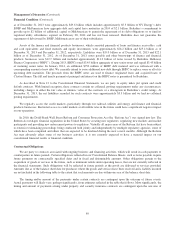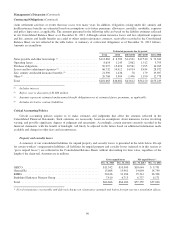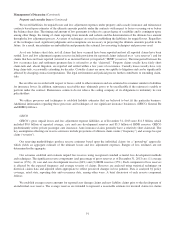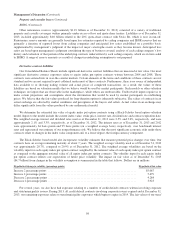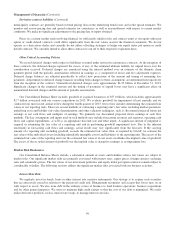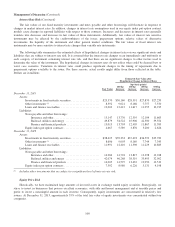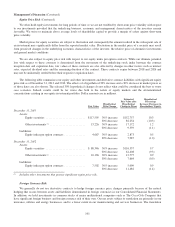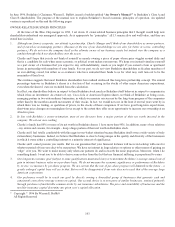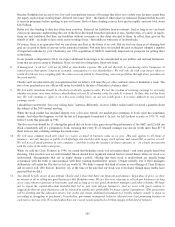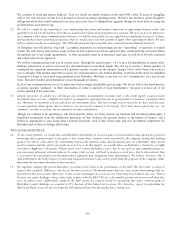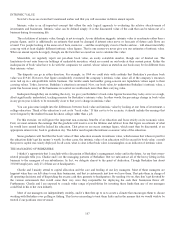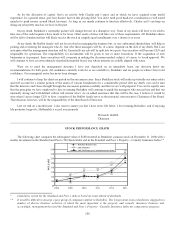Berkshire Hathaway 2013 Annual Report Download - page 101
Download and view the complete annual report
Please find page 101 of the 2013 Berkshire Hathaway annual report below. You can navigate through the pages in the report by either clicking on the pages listed below, or by using the keyword search tool below to find specific information within the annual report.Management’s Discussion (Continued)
Derivative contract liabilities (Continued)
municipality contracts are generally based on bond pricing data on the underlying bond issues and credit spread estimates. We
monitor and review pricing data and spread estimates for consistency as well as reasonableness with respect to current market
conditions. We make no significant adjustments to the pricing data or inputs obtained.
Prices in a current market trade involving identical (or sufficiently similar) risks and contract terms as our equity index put
option or credit default contracts could differ significantly from the fair values used in the financial statements. We do not
operate as a derivatives dealer and currently do not utilize offsetting strategies to hedge our equity index put option or credit
default contracts. We currently intend to allow these contracts to run off to their respective expiration dates.
Other Critical Accounting Policies
We record deferred charges with respect to liabilities assumed under retroactive reinsurance contracts. At the inception of
these contracts, the deferred charges represent the excess, if any, of the estimated ultimate liability for unpaid losses over the
consideration received. Deferred charges are amortized using the interest method over an estimate of the ultimate claim
payment period with the periodic amortization reflected in earnings as a component of losses and loss adjustment expenses.
Deferred charge balances are adjusted periodically to reflect new projections of the amount and timing of remaining loss
payments. Adjustments to deferred charge balances resulting from changes to these assumptions are determined retrospectively
from the inception of the contract. Unamortized deferred charges were approximately $4.35 billion at December 31, 2013.
Significant changes in the estimated amount and the timing of payments of unpaid losses may have a significant effect on
unamortized deferred charges and the amount of periodic amortization.
Our Consolidated Balance Sheet includes goodwill of acquired businesses of $57.0 billion, which includes approximately
$2.7 billion associated with our various acquisitions in 2013. We evaluate goodwill for impairment at least annually and we
conducted our most recent annual review during the fourth quarter of 2013. Our review includes determining the estimated fair
values of our reporting units. There are several methods of estimating a reporting unit’s fair value, including market quotations,
underlying asset and liability fair value determinations and other valuation techniques, such as discounted projected future net
earnings or net cash flows and multiples of earnings. We primarily use discounted projected future earnings or cash flow
methods. The key assumptions and inputs used in such methods may include forecasting revenues and expenses, operating cash
flows and capital expenditures, as well as an appropriate discount rate and other inputs. A significant amount of judgment is
required in estimating the fair value of a reporting unit and in performing goodwill impairment tests. Due to the inherent
uncertainty in forecasting cash flows and earnings, actual results may vary significantly from the forecasts. If the carrying
amount of a reporting unit, including goodwill, exceeds the estimated fair value, then, as required by GAAP, we estimate the
fair values of the individual assets (including identifiable intangible assets) and liabilities of the reporting unit. The excess of the
estimated fair value of the reporting unit over the estimated fair value of its net assets establishes the implied value of goodwill.
The excess of the recorded amount of goodwill over the implied value is charged to earnings as an impairment loss.
Market Risk Disclosures
Our Consolidated Balance Sheets include a substantial amount of assets and liabilities whose fair values are subject to
market risks. Our significant market risks are primarily associated with interest rates, equity prices, foreign currency exchange
rates and commodity prices. The fair values of our investment portfolios and equity index put option contracts remain subject to
considerable volatility. The following sections address the significant market risks associated with our business activities.
Interest Rate Risk
We regularly invest in bonds, loans or other interest rate sensitive instruments. Our strategy is to acquire such securities
that are attractively priced in relation to the perceived credit risk. Management recognizes and accepts that losses may occur
with respect to assets. We also issue debt in the ordinary course of business to fund business operations, business acquisitions
and for other general purposes. We strive to maintain high credit ratings so that the cost of our debt is minimized. We rarely
utilize derivative products, such as interest rate swaps, to manage interest rate risks.
99


